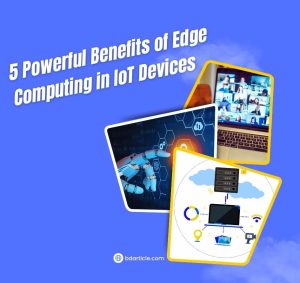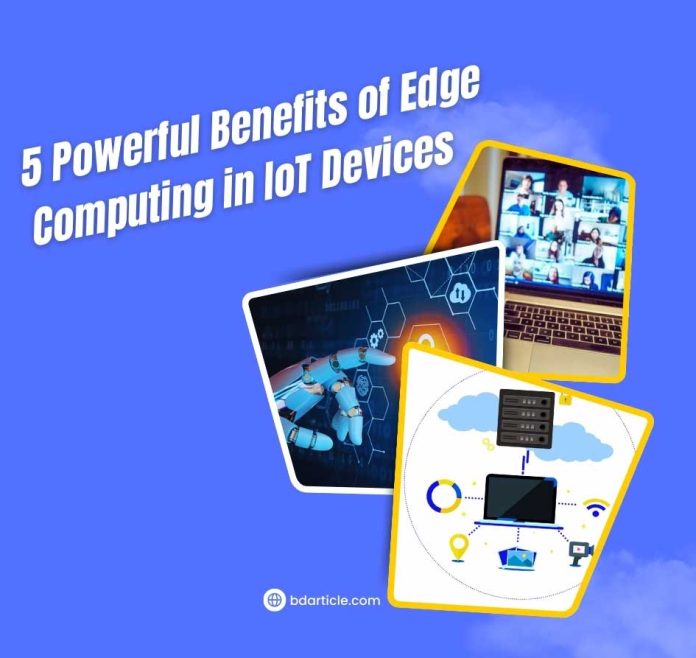Edge computing in IoT devices has revolutionized how data is processed, bridging the gap between traditional centralized cloud systems and the growing need for real-time responsiveness. Unlike cloud-reliant models, edge computing decentralizes data processing, bringing computation closer to its source—the “edge.” This shift enables IoT devices to analyze and act on data locally, reducing latency and enhancing system efficiency.

As IoT ecosystems expand, the data generated grows exponentially. Edge computing addresses critical challenges such as performance bottlenecks, scalability, and data privacy, making it a cornerstone of modern IoT strategies. Businesses across industries can leverage this technology to optimize resource utilization, reduce costs, and ensure secure data handling.
Enhanced Data Processing Efficiency
A key advantage of edge computing in IoT devices is its ability to process data closer to its source, drastically improving efficiency. Traditional cloud computing in IoT involves transmitting data to centralized servers for processing, which can result in significant delays. Edge computing eliminates this bottleneck by handling data locally, reducing latency, and enabling faster decision-making.
Edge Computing in IoT Devices Examples
Real-world examples highlight the transformative impact of edge computing. Autonomous vehicles depend on split-second decisions to ensure safety. With edge computing, these vehicles analyze data from sensors and cameras in real-time, bypassing the delays of remote server processing. Similarly, in smart factories, IoT edge devices monitor equipment performance and optimize production lines without relying on consistent cloud connectivity. This local data processing ensures seamless, efficient operations, even in environments with limited internet access, demonstrating edge computing’s essential role in modern IoT ecosystems.
Improved Data Privacy and Security
Edge computing offers a significant advantage in improving data privacy and security, a critical concern in IoT ecosystems. When considering which of the following is a primary benefit of edge computing in terms of data privacy, reduced exposure to breaches is a standout feature. By processing and storing data locally at the edge, reliance on centralized cloud storage decreases. This minimizes vulnerabilities during data transmission, reducing the risk of cyberattacks and unauthorized access.
Fog Computing in IoT further enhances security by acting as an intermediary layer. It complements edge computing by facilitating secure communication between devices and cloud services. This layered architecture ensures robust protection for sensitive information, particularly in industries like healthcare and finance, where data privacy is non-negotiable. For instance, medical IoT devices can analyze patient data locally and only send non-sensitive summaries to the cloud, maintaining compliance with stringent privacy regulations while ensuring operational efficiency.
Reduced Latency for Real-Time Applications
Edge computing excels in reducing latency, a critical factor for IoT applications that require real-time responses. Industries such as healthcare, transportation, and smart cities rely on instantaneous data processing to ensure seamless operations and timely decisions. By processing data locally, edge computing eliminates the delays caused by transmitting information to remote servers and back. This ensures mission-critical tasks, such as emergency response systems and medical monitoring, function without disruption.
IoT Edge Computing Architecture
The architecture of edge computing decentralizes processing power, enabling local decision-making. In transportation, for example, smart traffic systems leverage edge computing to adjust traffic lights dynamically based on live vehicle flow data. These rapid, localized responses optimize traffic patterns, reduce congestion, and enhance urban mobility. Unlike cloud-dependent systems, this architecture ensures reliable, real-time performance, even in areas with limited connectivity, making it indispensable for modern IoT ecosystems.
Cost Savings and Scalability
Edge computing optimizes resource utilization, resulting in substantial cost savings for IoT implementations. As IoT networks grow, the data generated becomes immense, making constant transmission to centralized cloud systems both expensive and bandwidth-intensive. Edge computing addresses this challenge by processing data locally, reducing reliance on costly cloud services, and alleviating network strain. This local processing minimizes operational expenses while maintaining system efficiency.
Edge Computing IoT Examples
A notable example is the retail industry, where IoT edge devices are used for inventory management. These devices track stock levels and analyze customer behavior directly at the edge, eliminating the need to transfer large datasets to the cloud. This reduces data handling costs and ensures real-time responsiveness. Furthermore, as businesses scale and add new devices, edge computing enables seamless integration without significant increases in data transfer expenses, providing a highly scalable and cost-effective solution.
Enhanced Reliability and Network Resilience
Edge computing significantly boosts the reliability and resilience of IoT systems by ensuring they remain operational during network outages or disruptions. Unlike cloud-reliant models, edge devices locally process and analyze data, reducing dependency on constant connectivity. This local processing ensures uninterrupted performance in critical applications, such as industrial automation or healthcare, where delays could have serious consequences.
Edge vs IoT: Integration for Success
Edge computing complements IoT by enhancing its real-time processing capabilities, but it does not entirely replace cloud solutions. A hybrid approach combining edge and cloud computing delivers optimal results. Critical data requiring immediate action is processed at the edge, while less time-sensitive information is sent to the cloud for storage and detailed analysis. This integration balances performance and scalability, creating a robust IoT architecture that ensures reliability while maximizing the potential of both technologies.
Revolutionary Bioinformatics Enhances Personalized Medicine
Edge computing plays a pivotal role in advancing bioinformatics, particularly in personalized medicine. By leveraging IoT edge devices like wearable health monitors, real-time data analysis becomes seamless. These devices track vital signs such as heart rate, blood pressure, and oxygen levels, processing the information locally without relying on cloud-based systems. This reduces latency, enabling immediate feedback for users and healthcare providers. Patients benefit from timely interventions, while doctors gain actionable insights to tailor treatments effectively. In critical scenarios, such as managing chronic illnesses or detecting anomalies, this rapid analysis empowers decision-making. Edge computing thus bridges the gap between data collection and personalized care, revolutionizing how health data is used to enhance individual well-being.
External Resources for Deeper Insights
- Explore how ‘IoT and Cloud Computing‘.
- Discover how ‘Fog computing in IoT.‘
#Edge_Computing_in_IoT_devices #IoT_edge_devices #Edge_computing_in_IoT_devices_examples

